Case Study: Hitting Page 1 for a 50k Search Keyword with an Aged Domain
Matt Diggity
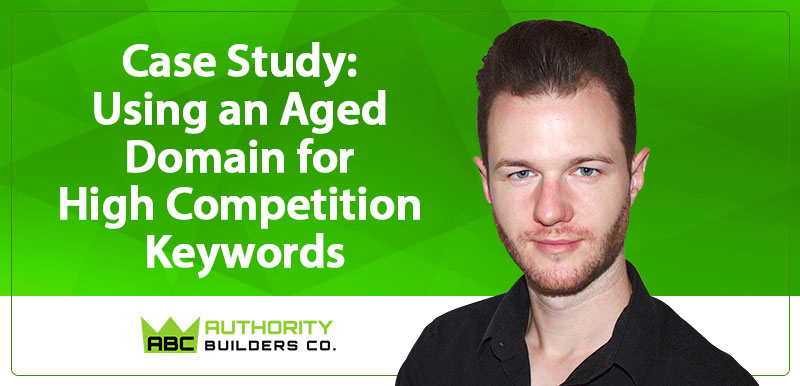
Foreword by Matt Diggity
There’s a lot of confusion around ranking aged domains..
Sometimes they work great and they get you a quick edge over using a brand new domain.
And sometimes they fail miserably.
Constantin Oesterling is a member of The Affiliate Lab since the beginning and is one of the top contributing members.
He’s about to take you though the whole journey of how he took a 50k search/month affiliate keyword from nowhere to page 1 using an aged domain.
You’ll learn about his technical setup, his onsite optimization strategies, and the backlinks he built in this follow-along case study.
Introduction
I’m not going to bore you with fluff and theories.
Instead, I’ll share every step of my journey from not ranking at all to ranking on page 1 for a money keyword with more than 50,000 searches per month (80%+ U.S. traffic) using an aged domain.
You won’t find long explanations why I think something worked or didn’t work, but just the details of what exactly I did and what happened.
Anyway, let’s jump right into it.
Q2 2018: Niche and Domain Selection
Instead of researching a niche and finding a domain, I bought a pre-built site on an aged and semi-relevant domain from DominatingPBNs.
The niche was in home improvement and looked promising. Although monetized with Amazon, it’s a category with “OK” commissions considering the relatively high average product price.
The domain looked great, as well. It had 100+ RDs already, including some quite powerful ones. This meant I had to build fewer pillow links and would likely get a head start.
The site itself had about 10 pages with a total of 20k words. Half of them money pages, the other half informational ones.
It’s a branded domain with a portal homepage, which both were important factors for me.
While micro niche sites work well too, I just prefer branded domains.
Overall a cool package to get started without having to do much more than building links and adding content (or so I thought).
The site didn’t have any visitors to speak of when I bought it. Maybe 10 a day, maybe less.
One issue was the SERP layout for the main keyword I talk about here. It’s got ads, of course, featured snippets, people also ask, videos, Google shopping, and even a freakin’ map pack.
Due to the layout, I knew I wouldn’t get many clicks unless I actually rank #1 and not just on page 1.

I also had to beat Amazon, Walmart, Wayfair, and several niche-specific authority sites with DR60+ domains.
But who doesn’t like a little challenge?
I figured if I get the page to rank for its main keyword, it will rank for related keywords, and long-tails. These areas would have less clustered SERPs.
Q2 2018: Initial Site Tweaks
These are the first tweaks I applied to the site after I bought it.
Bloat Removal
One of the first things I like to do with every WordPress site is to remove some of the bloat it adds to pages.
Clearfy is a great plugin for that. Below are the settings I usually apply.
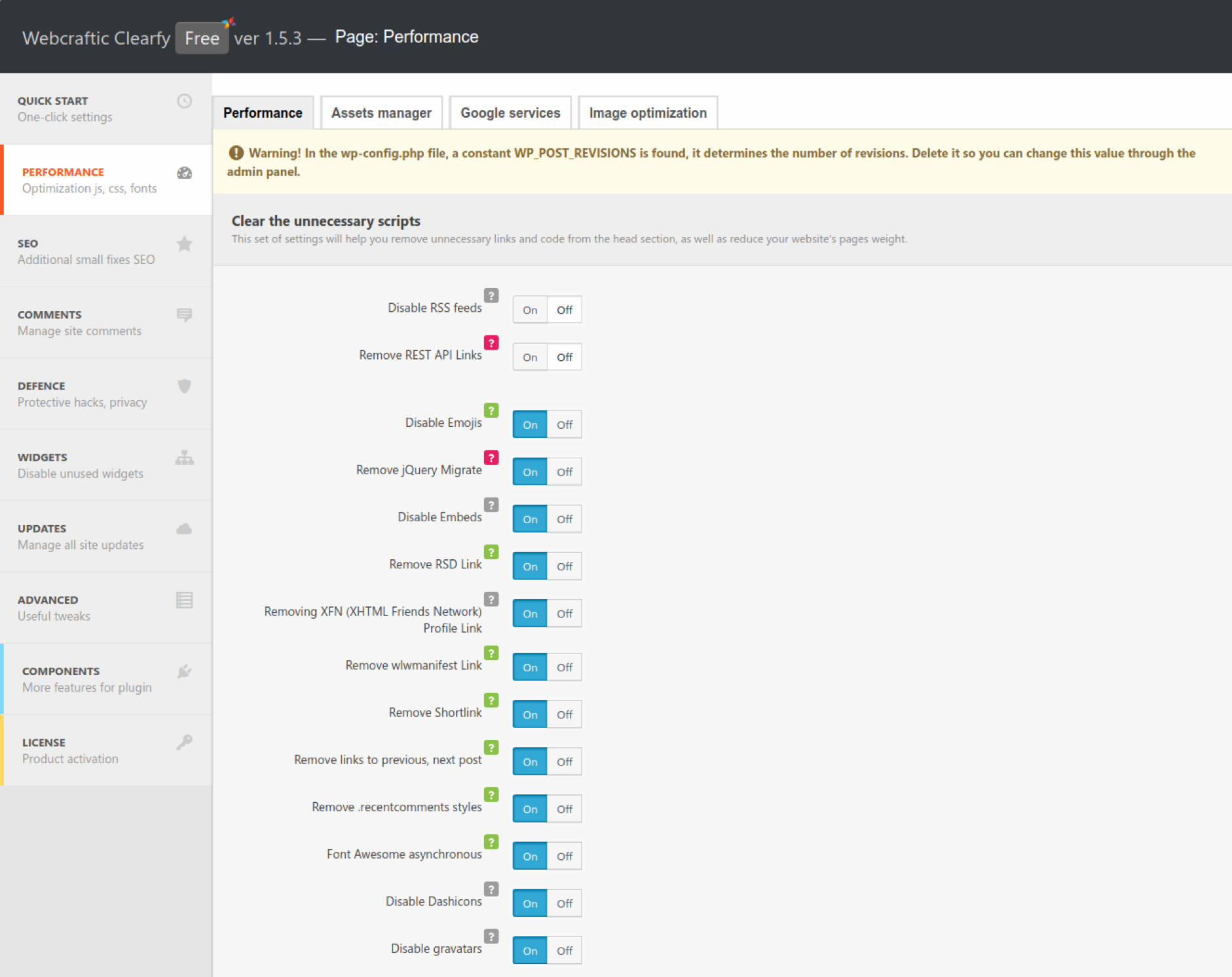
Performance Optimization
I didn’t only want the site to be as bloat-free as possible with WordPress, but also, loading as fast as possible.
This meant moving the site to a WordPress hosting setup that allowed me to squeeze as much performance out of it as possible.
Matt has an in-depth article on hosting for SEO on his blog.
The money page in question has a huge amount of content on it, including images, tables, etc. and still loads in less than 2 seconds, which is good enough for me (and Google).
I also optimized all images using Shortpixel, which usually has a huge impact on page size and speed.
SEO Plugin
Although I don’t think it matters too much which SEO plugin you use as long as it’s a decent one, I just love Rank Math and that’s what I migrated the site to.
Meta Data Tweaks
I also went through all meta titles and descriptions and tweaked them for higher CTRs.
I like to make sure the main keyword is being mentioned first and to repeat it in the meta description.

The style I usually use looks like this:
Title: Best Blue Button 2019 (Unbiased & Detailed Review)
Description: Want to get the best blue button money can buy? Make sure to read our review before you end up with a turquoise one.
Basic CRO
In this case, I didn’t have to do much other than to adjust the style of the CTA buttons and change the button text from “Check Latest Price on Amazon” to just “Check Price.”
Since the design and layout were already decent, I didn’t worry too much about low click rates.
Internal Anchors
I decided to go heavy on internal keyword anchors. About 80-90% of my internal anchors contain target keywords, secondary keywords, or synonyms.
I tested this a number of times and at least with a small number of pages, I found this to be safe and work rather well.
I don’t use branded or URL anchors at all internally.
Just either keywords or generic words if I feel like it makes sense to add a few non-keyword anchors to the mix.
Q2 2018: First Link Building Campaign
I started sending some links right after the initial tweaks. Because I don’t plan on flipping the site and it already had decent authority links, I figured it would be safe enough to use some generic PBNs.
In Q2 2018, I sent two guest post links and about 20 generic PBNs. The guest posts pointed to the money page, and the PBNs to various inner pages as well as the homepage.

For guest posts, I use Authority Builders. With their thorough vetting process and easy-to-use ordering, it takes most of the headache out of building guest posts.
Because which SEO would want to spend more time communicating with site owners and writers than doing actual SEO?
Anchor Strategy
I kept target anchors and secondary keywords limited to about 50% and the other 50% were generic, brand, and URL anchors.
I didn’t follow very specific ratios at this point.
If anchor text analysis starts to get too difficult, read this comprehensive guide.
Results
The money page wasn’t even ranking top 100 yet for the target keyword.
And I knew why…
Q3 2018: TF*IDF and More Links
It was time to launch WebSite Auditor and actually optimize the content.
So far I had only touched the meta titles and descriptions but hadn’t actually optimized the pages.
Keyword Selection for WebSite Auditor
I like to use the broad variation of the initial target keyword to optimize the content around that.
What I mean by this is instead of optimizing the content for “best blue button,” I’d optimize it primarily for just “blue button” while still keeping the “best” in meta title, description, and h1.
This way, money pages tend to rank for both and not just the “best” variation.
If you only optimize for “best blue button,” you potentially leave a ton of traffic on the table.
That being said, I still also run a TF*IDF analysis on “best blue button” to make sure I’m not heavily under- or over-optimized for either variation.
TF*IDF Optimization
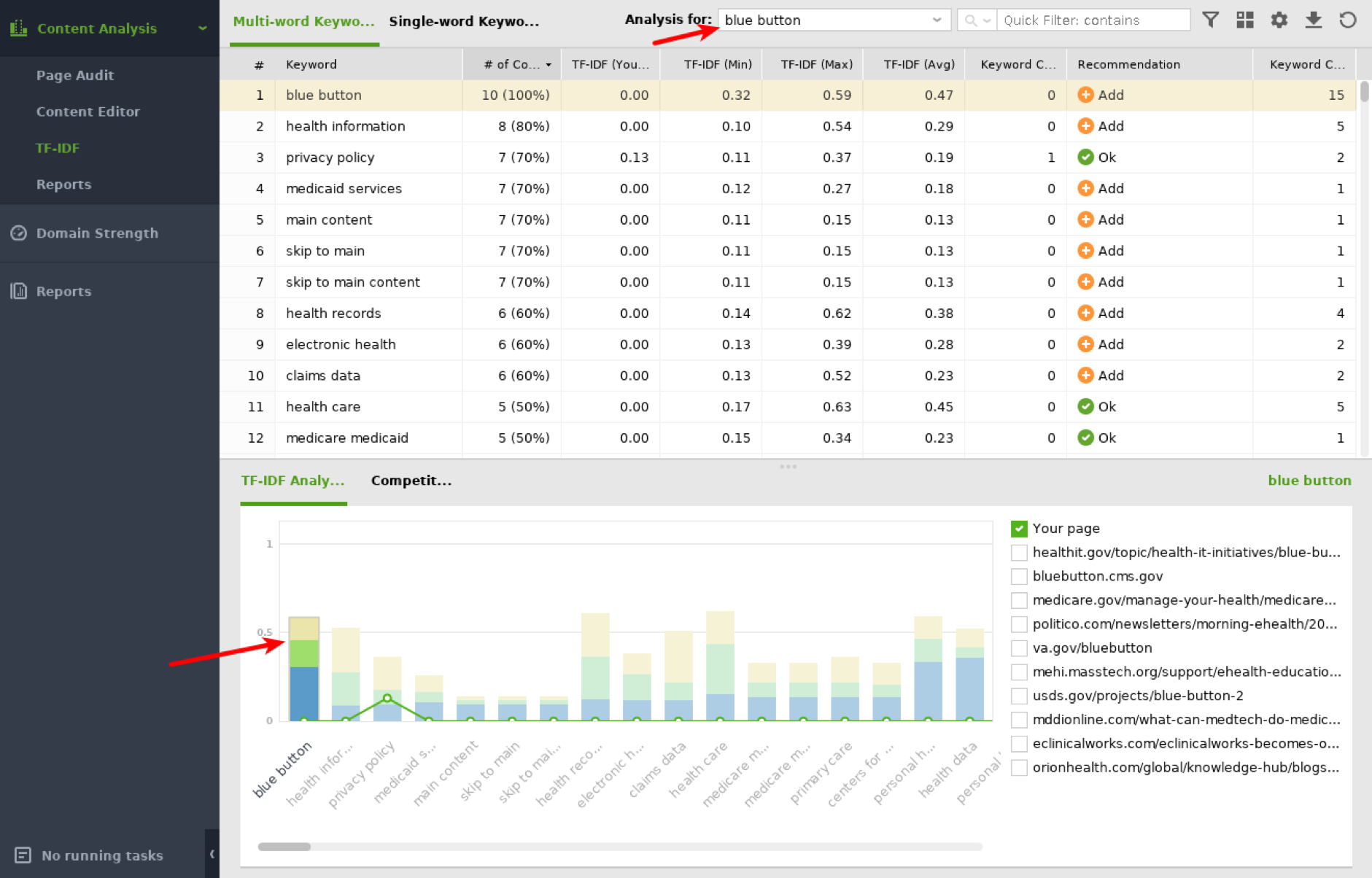
The first thing I do is to optimize the frequency of the main keyword.
My goal is to hit more or less exactly the transition between the green and the yellow part of the bars on the screenshot above. The bottom third of the yellow part is fine too.
I then switch to the “Single-word Keywords” tab and do the same for the words “blue” and “button.”
Then I would try to include all “Multi-word Keywords” on my page that 30% or more of the competing pages mention. I also pay attention to their frequencies.
For “Single-word Keywords,” I usually just include the ones that 50%+ of competing pages mention.
I also check how often the main keyword is being mentioned in subheadings and alt tags on average and would try to match that.

I optimized all money pages this way.
Link Building
In Q3 2018, I built about another 20 generic PBN links, more than half of which went to the homepage and just one or two to the money page in question.
I’m using that strategy mostly to get some link signals while working on the on-page factors and letting everything age.
I didn’t actually intend to really rank using these. They’re just better than no links if used in moderation.
Results
Nothing else happened in Q3 2018, because I’ve mostly been distracted with other projects and still do way too much of the work on my own.
What did happen was that the money page started to rank on page 5-7 of Google for its target keyword.
Q4 2018: It’s Alive!
Supporting Content
I added 5 child pages for the money page. Instead of using informational content, I decided to go with subcategories of the main product.
These subcategories included topics like “blue buttons for women,” “cheap blue buttons,” etc.
Then, the main money page linked to them contextually and the child pages linked back to the main money page.
Stronger Links
At this point, it made sense to build stronger links. The money page was already on page 2-3 of Google.
First, I added an anchor strategy to my Linkio setup. This makes it easier to track ratios, and indexation of the linking pages.

Next, I built Authority Builder 5 guest posts and 2 outreach link insertions to the money page. Then, I sent 4 guest posts to the new child pages and 4 strong niche-specific homepage PBN links.
For most of the PBNs, I pointed them at the homepage. This helps boost its rank, and at the same time, passes link juice down the money pages.
Results
By December 2018, I was ranking #12 for the target keyword. Rankings shot up after adding the child pages and more links.
But I still wasn’t able to break through to page 1.
Q1 2019: The (Endless?) Plateau
Playing with PBNS
I assumed that all I needed to break through to page 1 was more link power.
I sent about 10 PBNs, all homepage links from PBNs with 100+ RDs and most of them pointed to the money page I wanted to rank.
I built 5-7 guest post links as well and continued to build tier 2 links.
Citations & Other Pillow Links
To balance out the current link building campaign that heavily focused on inner pages at the time, I got a bunch of citations that were linking to the homepage.
Thanks to the already existing link profile of the aged domain, not too many were needed.
FAQ Section
To gain more featured snippets and relevance, I added a FAQ section at the bottom of the page that answered the “People Also Ask” questions that Google was showing for the main keyword.
Internal Anchors
I tested different internal anchor ratios to make sure there’s nothing wrong with the strategy I was using.
None of the ratios I tried made much of a difference, so I eventually reverted back to the one I was using initially.
Results
The rentals, citations, and on-page tweaks didn’t move the needle at all.
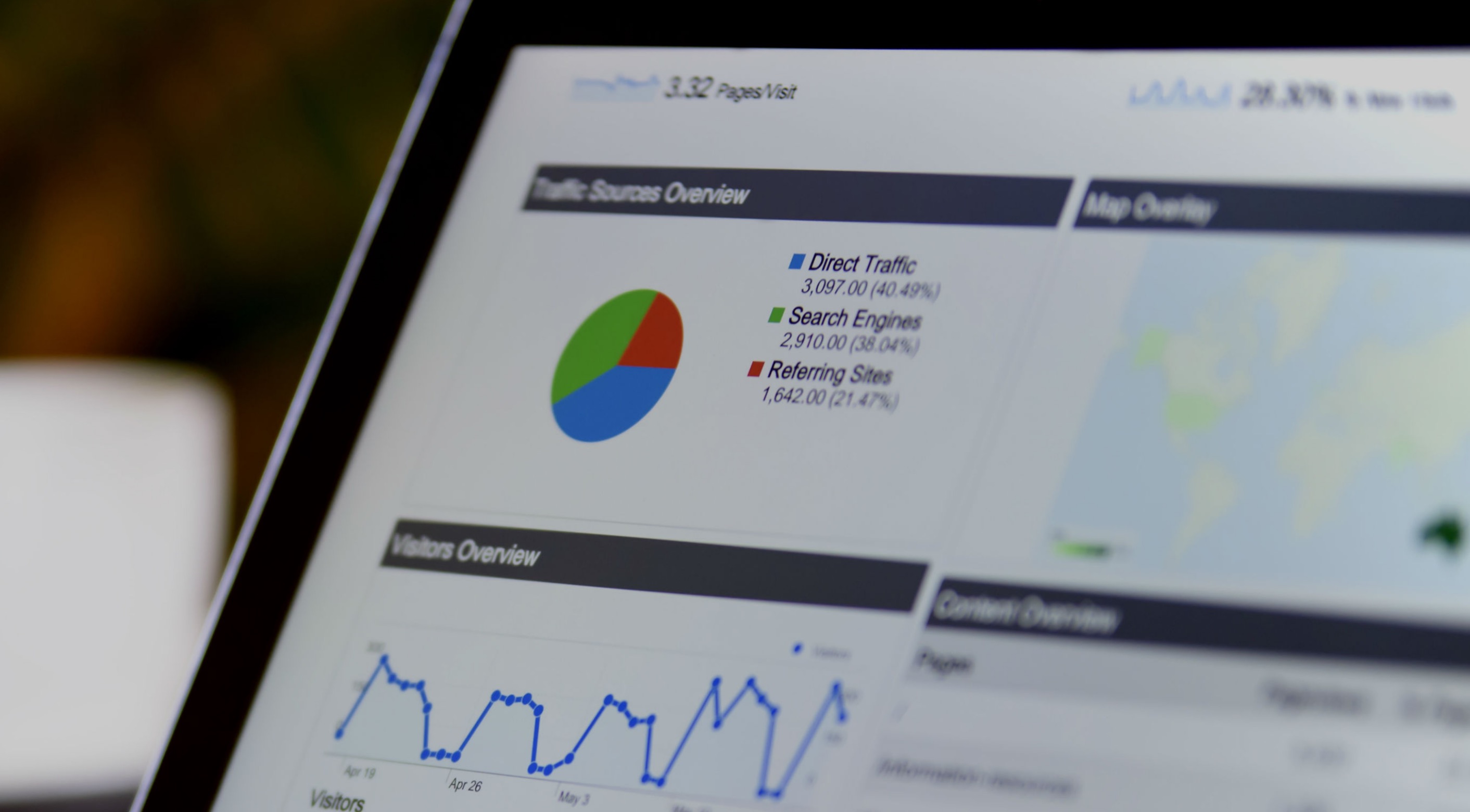
The rankings were plateauing for months and actually slightly dropping to the bottom of page 2.
I knew I had to do something more drastic than power up the page with links and play with small on-page tweaks.
Q2 2019: Hello Page 1
Removal of PBNS
I canceled all recent PBN links. They didn’t work in this case, so I wasn’t concerned about any drops if I wasn’t replacing them.
Better Links
I continued to build only ABC guest post links on relevant sites with DR40+ and organic traffic. No PBNs, and nothing weird.
Instead, just guest posts with a single special requirement:
The content of the guest posts had to mention my main keyword or a variation of it in its title.
In terms of anchors, I went heavier on brand anchors and less heavy on keyword and generic ones and completely stopped building URL anchors.
Keyword Cannibalization
All of the 5 supporting money pages I added under the main money page were also competing for the main target keyword.
This was happening to pretty much all of my competitors as well. And it wasn’t like the main money page was dropping out of the SERPs and getting replaced by one of these pages or anything like that.

The supporting pages were just ranking on page 3-4 for the same main keyword, while the main page was consistently on page 2.
They were also ranking well for their intended sub-product, and the SERPs for each of them clearly indicated that Google prefers to rank dedicated pages that target exactly these keywords, so I didn’t really like the idea of dropping them.
After the huge plateau that links couldn’t get the site out of, I still decided to merge these pages with the main money page to avoid any potential keyword cannibalization issues.
Fine-Tuning with Surfer
After I merged the pages, it was time to fine-tune the single remaining money page with Surfer.
I particularly paid attention to “Exact keyword density,” query word ratios, and popular words and phrases.
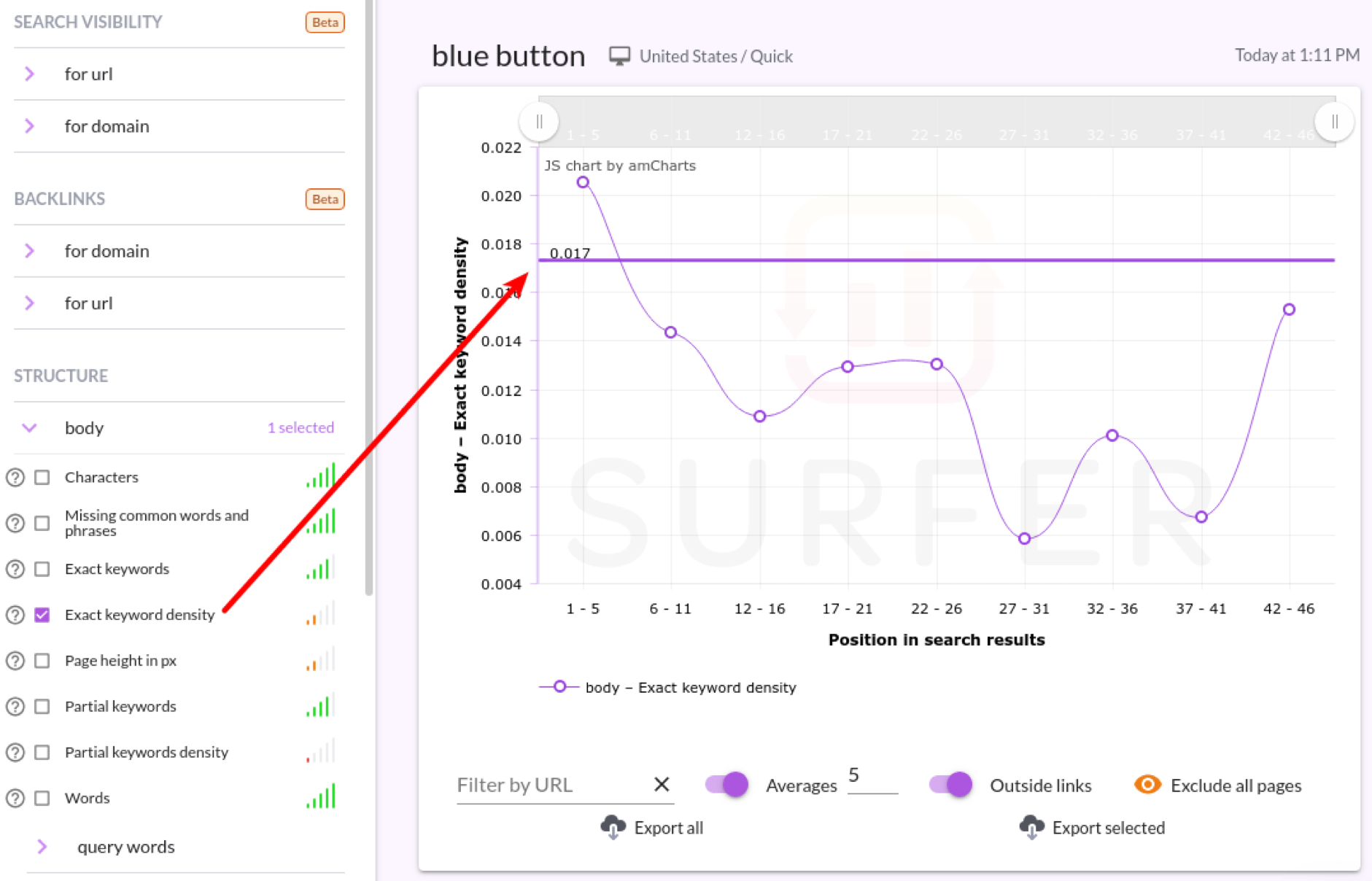

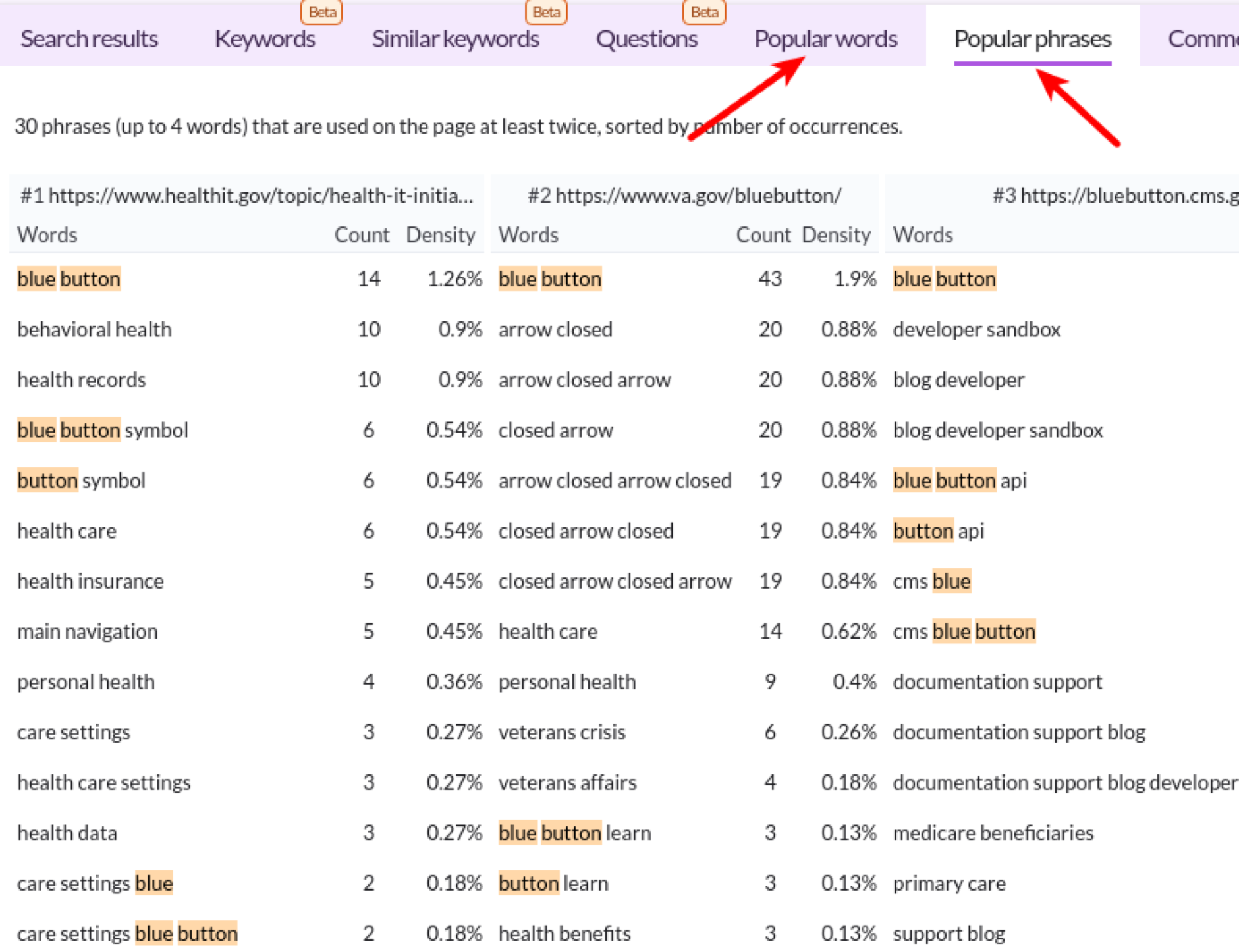
This should be self-explanatory.
I tried to get my densities as close to the top 5 as possible and excluded domains like Amazon from the analysis.
Outbound Links
I also added quite a few outbound links to decent external resources that answer a question related to the product category in more detail than my page.
Results
It took me two attempts to find the best keyword densities.

After that, I was back to the top of page 2 instead of the bottom of page 2.
In early June right before the Google update, the page jumped to the middle of page 1 for a day or two.
Since then it slightly dropped again but has remained on page 1 for almost 2 weeks now.
Unfortunately, the rankings of the child pages I merged didn’t really transfer to the destination page.
To this day, I’m not exactly sure if the mild cannibalization was actually an issue.
Or, if just the fine-tuning with Surfer and the content update when I merged the child pages along with better-optimized guest post links eventually caused the page to jump to page 1.
Takeaways (Warning: Some Speculations)
Using an aged domain did give me a head start and allowed me to use PBNs at an early stage. It was already ranking for some long-tail variations when I bought it. If you need to check the age of a domain, you can use our free tool here.
TF*IDF optimization and fine-tuning of densities with Surfer did have a positive impact on rankings and should be part of every on-page SOP this year.
It’s also a good idea to keep your site fast, bloat-free, and implement Schema (Rank Math handles that partially).
Keyword cannibalization may or may not have been an issue in this particular case. Due to the way I resolved it, it’s impossible to know for sure if it was. But in general, it’s always a good idea to avoid it.
When building links, it makes sense to make sure the sites receive organic traffic, have decent metrics, aren’t link farms that link to too much spam and to keep the linking content as relevant as possible to the target page.
In terms of anchors, going heavy on “branded + natural” and “branded + partial match” seems to work well currently, while just natural/generic and URL anchors seem to have the least impact on rankings.
You can rank sites with just content updates, content optimization, and link building. There is no need to add a ton of pages to get started or even to publish new ones frequently.
If you start a new site, don’t repeat my mistake. Make sure you actually have the time and resources to rank it within a couple of months.
If I hadn’t been as distracted by other projects, I’m sure I could have ranked this site in half the time.
Conclusion
It was a long and bumpy ride, but the money page eventually got on page 1 and is ranking between huge authority sites.

(It looks like it’s dropping in and out of SERPs right now, but that’s just Ahrefs not being accurate – I verified this with several other rank trackers and manual checks)
The money page picks up about 4,000 visitors per month, 30% of them click on Amazon links resulting in lower four figures of monthly commissions.
Overall an interesting challenge, because I really wasn’t sure if I could actually make it to page 1 with the limited time and resources I had allocated to that site, especially when I hit a plateau.
So in summary, we’ve discussed my technical setup, optimization techniques and backlink strategies in this month-to-month follow along case study.
If you have any questions, feel free to ask in the comments below.
